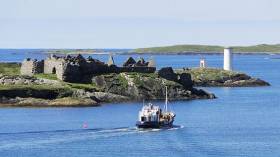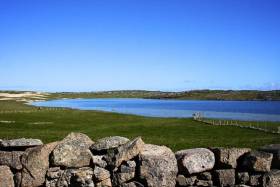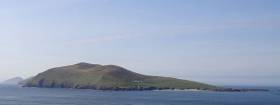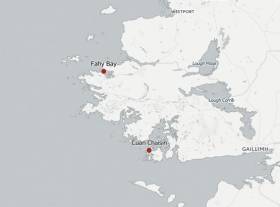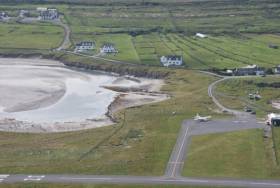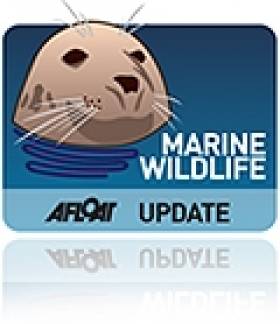Displaying items by tag: Connemara
'Pirate Queen' Castle Relic Found On Inishbofin
#Inishbofin - Archaeologists say a decorated stone found recently on Inishbofin was once part of a 'lost' castle stronghold of Connemara's 'pirate queen' Grace O'Malley, as The Irish Times reports.
References to two castles held by the O'Malley clan on the island off Connemara in the Middle Ages -- part of a string of fortifications along the coast -- have been confirmed only by minor traces, such as a window fragment at Dún Gráinne.
But the doorway stone recently identified within the 100-year-old boundary wall of Daly's pub is said to be the strongest evidence yet of a castle last recorded on 19th-century maps of the island.
The Irish Times has more on the story HERE.
900-Year-Old Brooch Found On Omey Island
#Archaeology - It was quite a turn-up for the books on Omey Island recently as a US student found a 12th-century brooch in the sand on the Connemara tidal island.
As The Irish Times reports, the rare kite brooch was discovered by chance by McKenna McFadden while on a field trip with fellow New York University students led by Michael Gibbons, a local archaeologist.
It's since been identified as being 900 years old, and will be offered to the collection of the National Museum.
Omey Island is also the subject of a new book charting its remarkable history, as previously reported on Afloat.ie.
#OmeyIsland - Omey Island in Connemara is the subject of a new book by a local woman charting its remarkable history.
Strands of Omey's Story by Bernadette Conroy shows there's much more to the lands off Claddaghduff than the annual beach horse race, as Galway Bay FM reports.
Despite not being a true island, as its only cut off from the mainland when the tide is in, Omey has seen its population dwindle from over 100 a century ago to just a single resident in more recent years.
#WildAtlanticWay - Minister of State for Tourism Patrick O’Donovan has announced almost €1.125 million in funding from Fáilte Ireland’s Capital Grants Allocation for two key projects along the Wild Atlantic Way.
A grant of is being made available to Galway County Council will receive €896,000 for the Connemara Greenway, while a grant of €225,000 is being allocated to the Office of Public Works (OPW) towards the first phase of development of new visitor facilities on Great Blasket Island.
“I am delighted to announce these grants today as these two important tourism attractions will provide a serious contribution to the future success of the Wild Atlantic Way," said the minister last Wednesday (13 July).
"Tourism moves in a very competitive global market and capital development is one means by which we can ensure that we are fighting fit to win a good portion of overseas visitors and, thereby, gain a return on this investment through increased revenue and jobs regionally.”
The grant for the Connemara Greenway will fund a new section of the route from Cloonbeg to Athry, running adjacent to Ballynahinch Castle, with a view to completion in May 2017.
This development is part of a wider plan for the Clifden to Oughterard Greenway that will link up with the planned Greenway from Galway city to Oughterard – ultimately resulting in a 78km Galway to Clifden Greenway offering a cycling experience from city to coast with international appeal for cycling enthusiasts.
The Blasket Centre, meanwhile, is located on the Wild Atlantic Way at the halfway point of the Slea Head Drive on the Dingle Peninsula. It was developed as a heritage and visitor centre honouring the unique community who lived on the remote Blasket Islands until 1953.
Currently there are no visitor facilities on the island but the new grant will assist the OPW in their overall development of the site by funding new facilities and services on the island, expected to be completed later this summer.
“These grants are an investment in the visitor experience on the ground," said Fáilte Ireland chief executive Shaun Quinn. "While the Wild Atlantic Way has been warmly received at home and abroad, it is still an evolving project. It is vital that we continue to invest in the project to ensure that we open up its full potential.
"We have great natural landscapes along the west coast but we must also ensure that we have top class tourism infrastructure, whether facilities or interpretation, to match them.”
Minister O’Donovan also recently launched a new Fáilte Ireland Grants Scheme for Large Tourism Projects, which will provide a pool of €65 million in investment to develop new, or boost existing, tourism experiences and attractions across Ireland.
The scheme, which will run from 2016-2020, is now open for applications from the public, private and voluntary sectors including community groups. Under the scheme, capital grants in excess of €200,000 and up to a maximum of €5 million will be available.
#Shipwrecks - Two new shipwrecks have been discovered in Connemara in areas known to be used by smugglers in centuries past, as The Irish Times reports.
Currach fisherman John Bhaba Jeaic Ó Conghaíle found the skeletal remains of what's thought to be an 18th-century vessel at Cuan Chaisín in Ceantar na nOileáin.
Elsewhere, Fahy Bay resident Michael Barry located a second wreck, believed to date from the 19th century, near his home on the northwest Connemara coast – inshore from the Spanish Armada wreck Falco Blanco Mediano.
The area is known as the birthplace of sea captain George O'Malley, one of the most notorious smugglers of his day.
The Irish Times has much more on the story HERE.
#AranIslands - Inverin near Rossaveal in Connemara has been selected as the mainland terminal for the new Aran Islands air service tender, as Galway Bay FM reports.
The news will be some consolation to islanders angered by last year's award of the tender to Executive Helicopters, who planned to fly from the islands to Carnmore some 50km to the east of the Rossaveal ferry link.
That tender was cancelled at the end of September, with the previous contract with Aer Arann Islands later extended at the 11th hour, though it is set to expire this coming October.
More recently, MEP Marian Harkin visited the European Commission with two locals to voice their concerns over the particulars of any new tender for the vital air connection between the Aran Islands and the mainland.
Galway Bay FM has more on the story HERE.
Connemara Man Convicted of Illegal Fishing At Spiddal Pier
A Connemara man was convicted of an illegal fishing offence at Derrynea District Court on the 14th January. Before the court was Dara Conlon of Baile Liam, Spiddal, Co. Galway, who pleaded guilty to the possession of an illegally caught salmon at Spiddal Pier on the 2nd July, 2015. Mr. Conlon was observed fishing with a net close to the shore, not far from the mouth of the Boluisce River, and when searched he was found to be in possession of a salmon, which had been concealed under the net in his boat.
Judge Mary Fahy heard that the Boluisce River already suffers from very low salmon stocks, and due to the collapse in fish numbers it is now closed for angling. Conservation of the returning fish is very important to ensure as many salmon as possible can spawn, and to improve the low stock numbers. Given the importance of every fish to the river, she rejected the defence’s application to apply the Probation Act, and convicted Mr. Conlon on the charge of illegal possession of a salmon, fining him €100 with €450 costs.
Commenting on the case, Dr. John Conneely of Inland Fisheries Ireland (IFI), said: “The Boluisce River salmon stocks are extremely low compared to historical levels, and their survival in the river is under threat. Much investment of time and effort has gone into habitat improvement to improve fish stocks, and it is frustrating to see illegal fishing targeting a very vulnerable stock of fish. IFI Officers are committed to protecting the fish stocks of the catchment, and will continue to rigorously enforce fisheries legislation.”
CEO of IFI, Dr Ciaran Byrne, noted the importance of Salmon angling to rural areas, stating: “Such environmental crimes not only affect salmon stocks but also the ability of rural areas to attract visitors, support jobs and remain vibrant communities. I strongly urge the public to report any incidents of poaching or pollution to the IFI confidential 24 hour hotline on 1850 347424 and protect the fish, their habitat and rural communities.”
Connemara Fish Farms Need Freshwater Source
#FishFarm - Long-term solutions for freshwater treatment at Connemara fish farms are a priority as one local company seeks planning permission for a new pipeline, according to Galway Bay FM.
The moves come in the wake of recent controversy over illegal extraction of freshwater from lakes used to treat amoebic gill disease in salmon farms.
Údarás na Gaeltachta is now investigating longer-term freshwater availability for the growing aquaculture industry in south Connemara. Galway Bay FM has more HERE.
Council Warns Connemara Salmon Farms Over Illegal Freshwater Extraction
#FishFarm - Connemara's salmon farming industry has vowed to ensure it abides by all statutory regulations following the recent discovery of illegal freshwater extraction in the Kilkieran Bay area.
As Galway Bay FM reports, Galway County Council has been moved to write to the region's biggest salmon farming companies over their use of freshwater for disease control in their salmon farms.
This was prompted by the discovery of an illegal pumping system at Loch An Mhuilinn, similar to the unauthorised pipeline from Loughaunore that got Marine Harvest Ireland into trouble with the authorities last year.
Marine Harvest, along with the region's biggest producer Bradán Beo Teo, was sent a warning letter by the council in the wake of the latest find, for which it is not yet known who is responsible. The Connacht Tribune has more on the story HERE.
Sea Eagle Poisoned In Connemara 'Was About To Lay Eggs'
#MarineWildlife - The remains of a sea eagle – or white-tailed eagle – have been found in Connemara, and experts say the bird was poisoned.
RTÉ News reports on the discovery earlier this month of the female eagle, which was "within days" of laying eggs.
She was one of a pair that settled in the Roundstone area of Galway after her release in Killarney six years ago. Last year the pair laid eggs but they did not hatch.
The gruesome find marks the 13th poisoning of a sea eagle since they were reintroduced to the wild, and comes just weeks after the remains of another white-tailed eagle were found in Fermanagh.


























